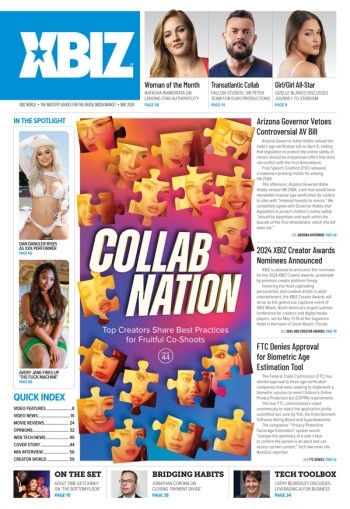AI is a hot topic. From automation to personal assistance to content generation, AI technology is already impacting our daily lives. Many industries, including adult, have had positive results using AI for customer support and marketing. It is transforming whole business sectors — and will undoubtedly reshape many aspects of the adult industry in fundamental ways. As a processor in the high-risk space, we are seeing at least one new AI site per week trying to onboard with us.
Many U.S. banks, however, are uncomfortable with AI technology and its sometimes unintended consequences. This is making the banks selective about which merchants they take on.
Adult companies need to stay on top of this developing technology, as it will doubtless change adult business models significantly.
So, what kind of AI content can you legally generate and what are the ethical considerations surrounding AI content? This month, we will dive deeper into this important issue, to help you stay ahead of the AI learning curve.
The Potential of AI Content Generation in Adult
Unlike traditional AI models, which follow predefined rules, “generative” AI can produce new text, images and other outputs. Generative AI plays a big role behind the scenes for many companies, helping to streamline the coding process and increase productivity. Generative AI also powers chatbots and other “conversational agents,” which most of us have likely encountered when chatting with customer service. This technology has enabled chatbots to communicate more naturally and become more helpful, as virtual assistants and in other customer support situations.
Generative AI models like OpenAI’s GPT3 are trained on vast datasets, allowing them to mimic human language patterns. They can create content autonomously, responding to prompts and generating, according to ChatGPT itself, “a wide variety of content depending on your interests, expertise and audience.” Such content can be tailored for users, based on their requests and preferences.
In addition to text, AI can create original music by analyzing musical patterns and styles. This could totally change the future of the music industry. AI can also generate realistic images and “artistic” creations, and help streamline video production and editing.
Adult companies need to stay on top of this developing technology, as it will doubtless change adult business models significantly. If AI can generate 15,000 images and videos of a model in a wide variety of situations, locations and outfits, all in a matter of seconds, this significantly reduces time and money spent on photo shoots and studio time. That will help platforms, models and content creators — but it will bring major change to the industry, just like cams did back in the early days of the internet.
Deepfakes and Consent
As most people know by now, AI can also create bogus content — convincing visual and audio hoaxes are known as “deepfakes.” Educators have used deepfakes to animate old images and footage, allowing historical figures to “come to life” in classrooms. Unfortunately, the technique has also been used in incidents like the recent dissemination of deepfake pornographic images of Taylor Swift that spread via X in January.
For a very small number of bad actors, this is a veritable feeding ground. Such incidents not only victimize real people, but raise red flags that get people worried about AI development and deployment, and thus impede moving this technology forward in the adult space.
Be aware that the card brands do not tolerate deepfake AI content. If Visa or Mastercard find deepfake content on a website, they may issue fines or shut the site down. Sites that include user-generated content therefore need to stick close to their developers, to get their best advice and guidance on spotting and removing deepfakes quickly.
Of course, the core principle when dealing with AI is consent. If you are generating images or voices based on a real person — remember all those instantly created situations, locations and outfits? — you must make sure that you have their explicit, documented consent to use and modify their image and/or voice in those ways. If you are creating a fake person based on multiple people, you must ensure that the final product does not resemble any of the individual people you used to generate it.
Quirks and Limitations
When using AI to create content, also bear in mind that despite how remarkable the technology is, it is by no means infallible. AI is only as good as its programming and the data it has been trained on. Always fact-check AI-generated content to avoid misinformation, and watch for unemotional and repetitive language. There are a few tools available to help with detecting those problems.
Bias can also enter the equation. The people writing code for bots and large language models are just that: people. Human beings are biased, so programmers’ assumptions can shape how AI generates content.
Finally, don’t forget that just like traditionally produced content, AI-generated content must be moderated and must abide by existing content rules as determined by regulators, local laws and the card brands. Those rules apply whether content is studio-produced, user-generated or created using a few lines of code.
Artificial intelligence is a truly transformative technology that is going to impact the world economy in ways we haven’t even thought of yet. Does that mean everything in adult is going to be 100% AI in five years? Of course not. Our industry is based on human emotion and human need. However, we are still discovering how best to utilize AI, while trying to keep up with its latest capabilities. The pace of progress in this area, and the potential benefits for the industry, will depend on the choices we make. Let’s be sure to make those choices in the most careful, ethical and well-informed manner possible.
Cathy Beardsley is president and CEO of Segpay, a merchant services provider offering a wide range of custom financial solutions including payment facilitator, direct merchant accounts and secure gateway services. Under her direction, Segpay has become one of four companies approved by Visa to operate as a high-risk internet payment services provider. Segpay offers secure turnkey solutions to accept online payments, with a guarantee that funds are kept safe and protected with its proprietary Fraud Mitigation System and customer service and support. For any questions or help, contact sales@segpay.com or compliance@segpay.com.






